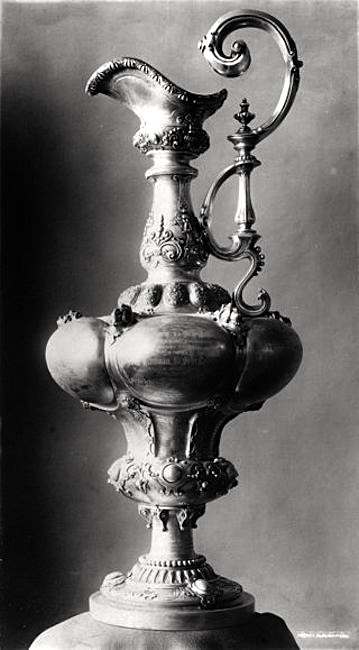Today’s morning name: ewer. An eminently useful object that has received the attentions of designers for millennia, craftsmen who lavished their skills on these objects to create items of great beauty. for instance;
From the Metropolitan Museum’s site:
Maker: Marc Bazille (1706–1777), Date: 1745–46, Medium: Silver, Dimensions: H. 10-1/4 in.
A ewer with its accompanying basin was among the most important components of the washing and grooming ritual known in France as la toilette. The ewer would have held water; the basin served as a small, portable sink. The intended function of this ewer and basin is made clear by the aquatic motifs chosen to decorate them. Beneath the spout of the ewer is a dolphin mask framed by bullrushes, and the finial of the hinged cover is formed by a dolphin whose tail serves as a thumbpiece. Bullrushes also decorate the inner sides of the basin.
This ewer and basin are among the Museum’s finest pieces of French Rococo silver. The sinuous lines of the ewer and its handle are a hallmark of the Rococo style, and the dolphin, appearing both in mask and finial form, was a frequently used motif.
(I’ve found nothing to suggest that Marc Bazille was a salon artist as well as a craftsman, though he does share the family name, and perhaps a family relationship, with the century-later Impressionist painter Frédéric Bazille (1841-70).)
On ewer the word and ewer the thing. From NOAD2 on ewer:
a large jug with a wide mouth, formerly used for carrying water for someone to wash in. ORIGIN late Middle English: from Anglo-Norman French ewer, variant of Old French aiguiere, based on Latin aquarius ‘of water,’ from aqua ‘water.’
Then from Wikipedia:
In US English, a pitcher is a container with a spout used for storing and pouring contents which are liquid in form. In English speaking countries outside North America, a jug is any container with a handle and a mouth and spout for liquid — American “pitchers” are more likely to be called jugs elsewhere. Generally a pitcher also has a handle, which makes pouring easier. A ewer is a vase-shaped pitcher, often decorated, with a base and a flaring spout, though the word is now unusual in informal English describing ordinary domestic vessels. An example of a ewer is the America’s Cup given to the winner of the America’s Cup sailing regatta match.
The sailing trophy, and the Wikipedia entry for it:
The Cup is an ornate sterling silver bottomless ewer, one of several off-the-shelf trophies crafted in 1848 by Garrard & Co. Henry William Paget, 1st Marquess of Anglesey bought one and donated it for the Royal Yacht Squadron’s 1851 Annual Regatta around the Isle of Wight.
Though I will be showing several more examples of beautiful ewers — chosen with difficulty from many dozens of examples available on the web — the America’s Cup is, to my taste, not one of these. “Ornate” scarcely begins to cover it; “wretched excess” is the phrase that comes to my mind. But others might find it charming.
While I’m on charming, consider this bird ewer (looks like an eagle — Latin aquila, but no etymological connection to the aqua ‘water’ in the history of ewer), probably from Iraq, c. 796-7 (brass, silver, and copper, with an inscription of the artist and date):
Now two commercial products of everyday materials but pleasing artistry: in pewter and in glass:
From an antiques site on #4 (capitalization and puctuation as in the original):
Antique English Victorian Pewter Miniature Ewer and Basin: An interesting Mid 19th Century Antique English Victorian Pewter Miniature Ewer and Basin, the ewer with attractive scroll handle, the basin with triple reeded edge. Unmarked. Too large we feel, to have been intended for use as a Doll’s House accessory, but rather more likely produced as a Travelling Salesman’s sample. Height of Ewer ~ 6.30 cm. / 2.50 inches
From an antiques site on #5:
Schneider Brown Tinted Glass Ewer: This small glass ewer is in a classical Schneider form with an elongated spout and a ribbon-like applied handle. The colour of this pitcher is a smart smoky brown. This piece dates c. 1925. Dimensions: Approximately 15.5 cm (6 in) maximum height.
… Charles Schneider was a brilliant and versatile designer, and the company produced a wide range of superb designs of vases, ewers, bowls, and lamps. They were very successful in marketing their glass to prestige retail stores both in Paris and overseas.
Then there are wonderful pottery ewers from China, from the Tang (618-907) and Song (960-1279) dynasties, a number with gorgeous celadon glazes.
All of these items were meant for daily use but also were, or have become, objets d’art. I stress once again that eminent functionality and artistic merit are in no way antithetical, whether in commercial illustration, industrial design, humorous art and writing, male photography, musical comedy, or hymn writing.





Leave a Reply